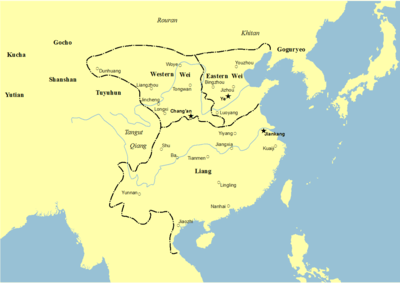Western Wei
| Western Wei 西魏 | |||||||||||
|---|---|---|---|---|---|---|---|---|---|---|---|
| 535–557 | |||||||||||
 Western Wei and neighbors | |||||||||||
| Capital | Chang'an | ||||||||||
| Government | Monarchy | ||||||||||
| Emperor | |||||||||||
• 535–551 | Emperor Wen of Western Wei | ||||||||||
• 552–554 | Emperor Fei of Western Wei | ||||||||||
• 554–557 | Emperor Gong of Western Wei | ||||||||||
| Historical era | Southern and Northern Dynasties | ||||||||||
| 8 November 534[1] | |||||||||||
• Emperor Wen's ascension, often viewed as establishment | 18 February 535[2] 535 | ||||||||||
• Disestablished | 14 February 557[3] 557 | ||||||||||
| Area | |||||||||||
| 557[4] | 1,300,000 km2 (500,000 sq mi) | ||||||||||
| Currency |
Chinese coin, Chinese cash | ||||||||||
| |||||||||||
| Today part of | China | ||||||||||
 | |||||||
|---|---|---|---|---|---|---|---|
| ANCIENT | |||||||
| Neolithic c. 8500 – c. 2070 BC | |||||||
| Xia dynasty c. 2070 – c. 1600 BC | |||||||
| Shang dynasty c. 1600 – c. 1046 BC | |||||||
| Zhou dynasty c. 1046 – 256 BC | |||||||
| Western Zhou | |||||||
| Eastern Zhou | |||||||
| Spring and Autumn | |||||||
| Warring States | |||||||
| IMPERIAL | |||||||
| Qin dynasty 221–206 BC | |||||||
| Han dynasty 206 BC – 220 AD | |||||||
| Western Han | |||||||
| Xin dynasty | |||||||
| Eastern Han | |||||||
| Three Kingdoms 220–280 | |||||||
| Wei, Shu and Wu | |||||||
| Jin dynasty 265–420 | |||||||
| Western Jin | |||||||
| Eastern Jin | Sixteen Kingdoms | ||||||
| Northern and Southern dynasties 420–589 | |||||||
| Sui dynasty 581–618 | |||||||
| Tang dynasty 618–907 | |||||||
| (Second Zhou dynasty 690–705) | |||||||
| Five Dynasties and Ten Kingdoms 907–960 |
Liao dynasty 907–1125 | ||||||
| Song dynasty 960–1279 |
|||||||
| Northern Song | Western Xia | ||||||
| Southern Song | Jin | ||||||
| Yuan dynasty 1271–1368 | |||||||
| Ming dynasty 1368–1644 | |||||||
| Qing dynasty 1644–1912 | |||||||
| MODERN | |||||||
| Republic of China 1912–1949 | |||||||
| People's Republic of China 1949–present | |||||||
The Western Wei (/weɪ/;[5] Chinese: 西魏; pinyin: Xī Wèi) followed the disintegration of the Northern Wei, and ruled northern China from 535 to 557. As with the Northern Wei state that preceded it, the ruling family of Western Wei were members of the Tuoba clan of the Xianbei.
After the Xianbei general Yuwen Tai killed the Northern Wei emperor Yuan Xiu, he installed Yuan Baoju as emperor of Western Wei while Yuwen Tai would remain as the virtual ruler. Although smaller than the Eastern Wei in territory and population, Western Wei was able to withstand the attacks from the eastern empire. Due to its better economical conditions, Western Wei was even able to conquer the whole western part of the Liang empire in the south and occupied the territory of modern Sichuan. In 557 Yuwen Tai's nephew Yuwen Hu deposed Emperor Gong and placed Yuwen Tai's son Yuwen Jue on the throne, ending Western Wei and establishing Northern Zhou.
Rulers
| Posthumous Names ( Shi Hao 諡號) | Born Names | Period of Reigns | Era Names (Nian Hao 年號) and their according range of years |
|---|---|---|---|
| Northern dynasty | |||
| Western Wei Dynasty 535-556 | |||
| Convention: Western Wei + posthumous name | |||
| Wen Di (文帝 wén dì) | Yuan Baoju (元寶炬 yuán bǎo jù) | 535-551 | Datong (大統 dà tǒng) 535-551 |
| Fei Di (廢帝 fèi dì) | Yuan Qin (元欽 yuán qīn) | 552-554 | Did not exist |
| Gong Di (恭帝 gōng dì) | Tuoba Kuo (拓拔廓 tuò bá kuò) | 554-557 | Did not exist |